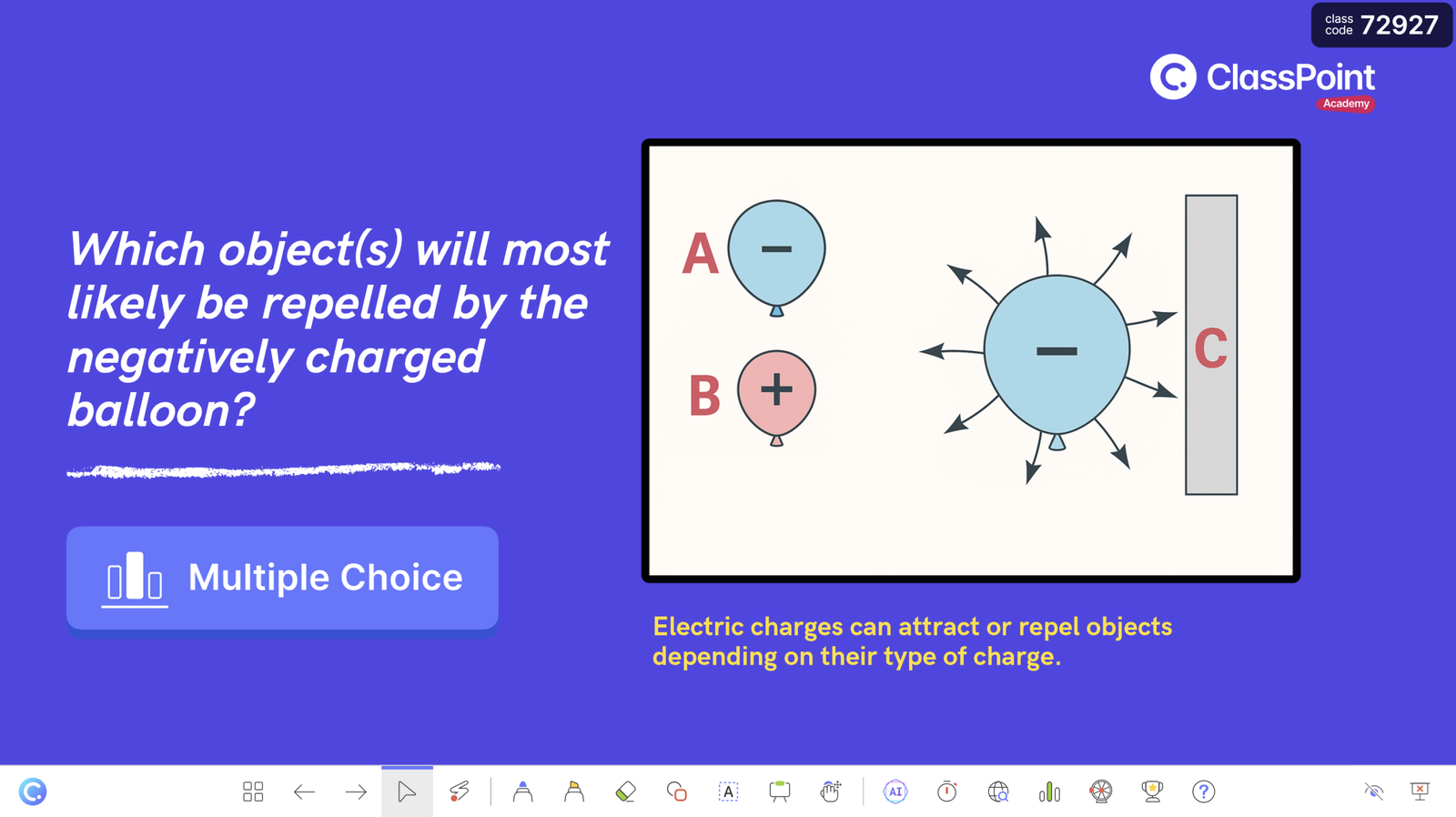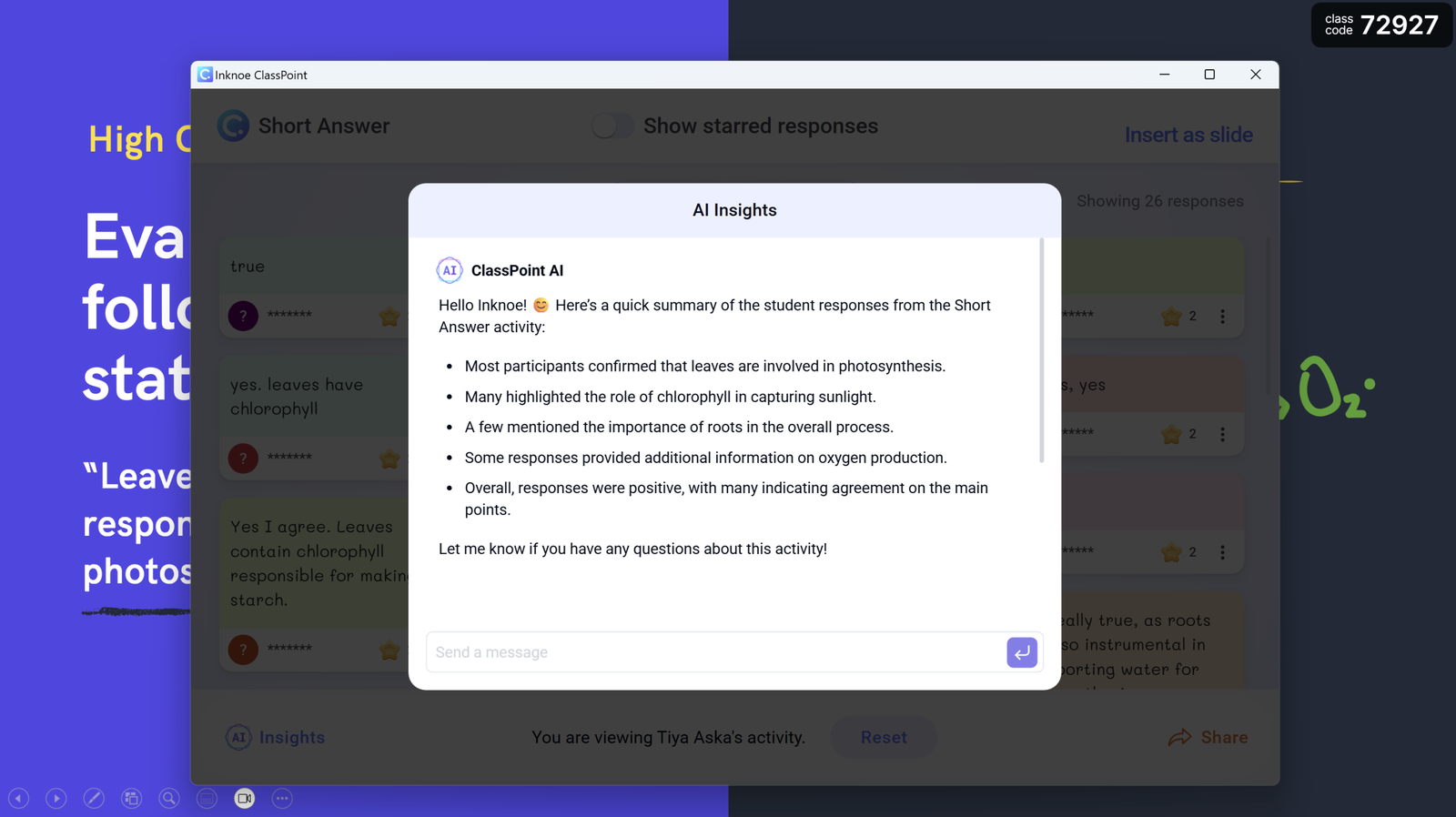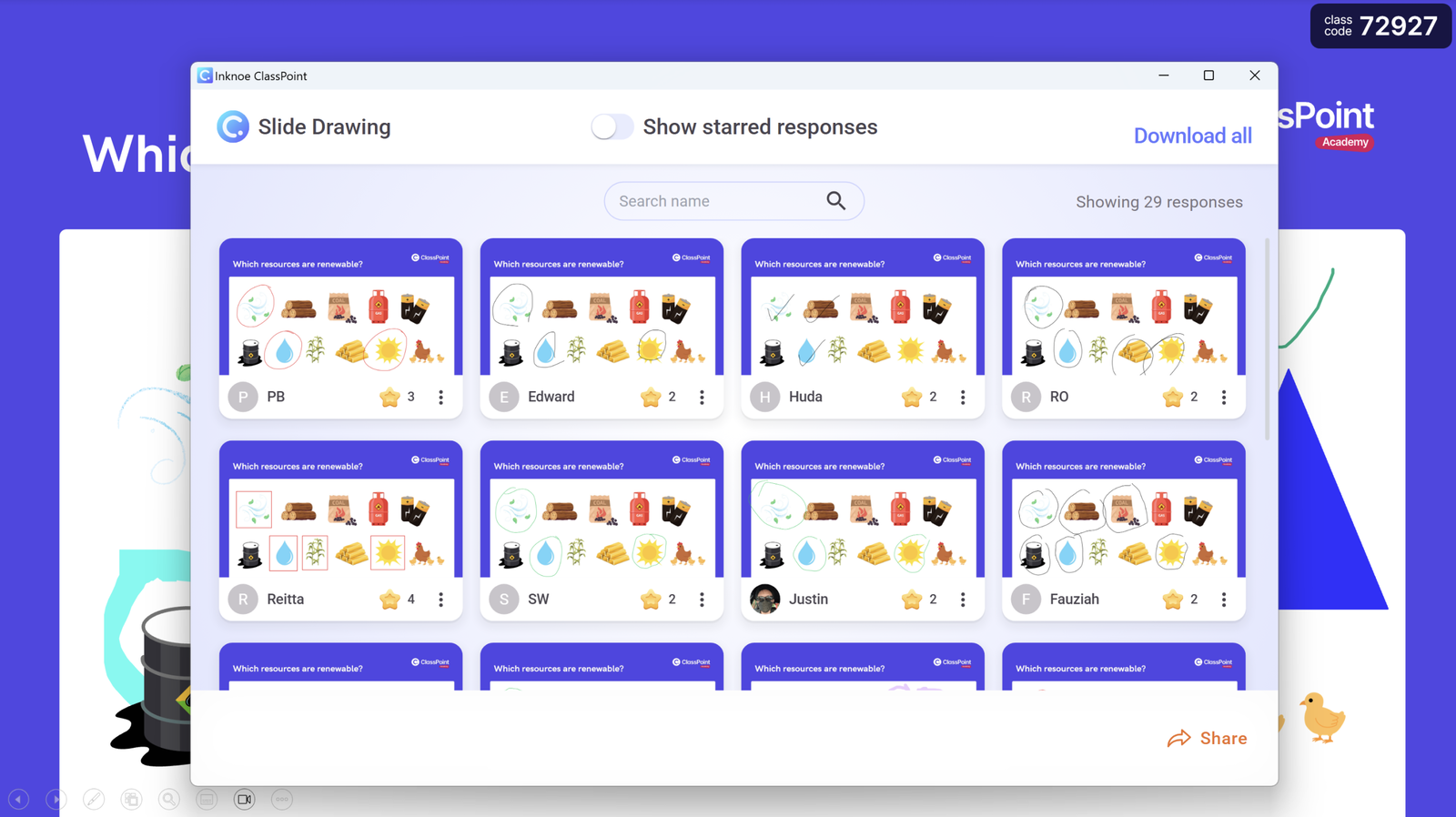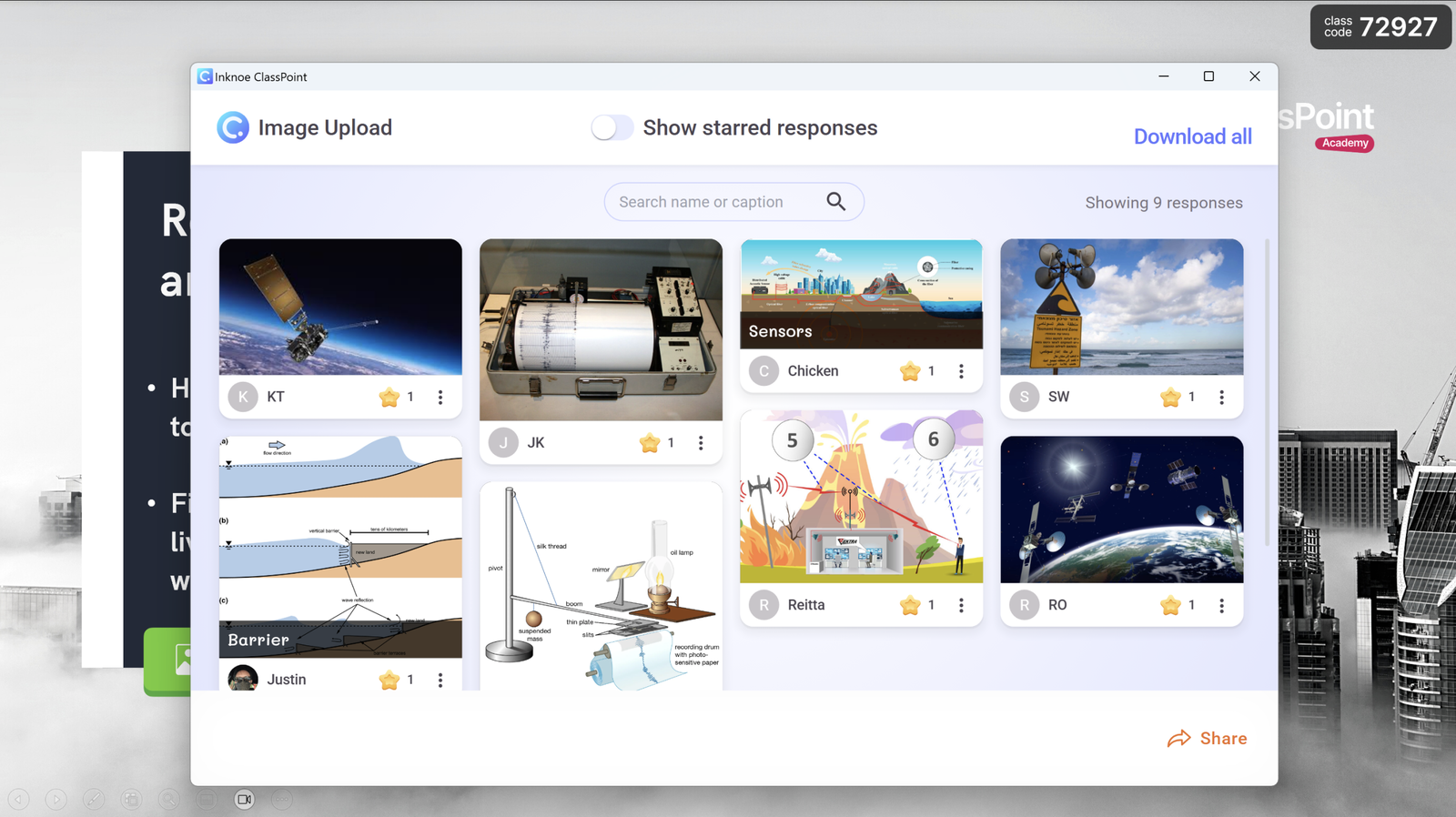Teaching science can feel challenging. Concepts are often complex, abstract, and at times intimidating for students. But the delivery makes all the difference. When lessons include interactivity rather than blocks and blocks of text in a presentation, even the hardest topics become easier to grasp.
The good news is that ClassPoint brings that interactivity right inside PowerPoint. The even better news? You don’t need to overhaul your slides.
We recently hosted a webinar with hundreds of educators eager to explore how ClassPoint can support science teaching. In this blog, we’re rounding up the best science teaching ideas we shared, each one designed to make your lessons more hands-on and memorable.
Every example below can be built into your existing PowerPoint deck as a question slide or prompt, then made interactive with ClassPoint. Students join from their own devices, submit answers live, and you can instantly review responses, award stars, or spark discussions, all without leaving your presentation.
Let’s get started!
1. Multiple Choice Questions
Charges and Forces
One way to use multiple choice in teaching science is through objective questions with one clear answer.
You can create a question slide with an image of a negatively charged balloon and ask: “Which objects will most likely be repelled by the balloon?” Instead of just listing A, B, C, you can display the objects as visuals in which students select the one that demonstrates the concept correctly. Then, embed a ClassPoint Multiple Choice button!

Motion and Measurement
Multiple choice also works when you want students to recognize more than one correct answer.
For example: “A car travels north at 80 km/h. What two measurements of the car’s motion are given?” Here, students can choose both speed and direction. Allowing multiple selections challenges them to think critically and check their understanding of motion beyond a single fact.
Other science teaching ideas with ClassPoint’s Multiple Choice:
- Show images of food chains and ask students to identify the producer, consumer, or decomposer.
- Present diagrams of circuits and ask which one will light the bulb.
- Display different planetary models and ask which best represents Earth’s rotation and revolution.
- Use before-and-after experiment pictures (like melting ice vs. solid ice) and ask which physical change occurred.
Why it works: Multiple choice questions are versatile in teaching science. When designed with visuals, they help students see concepts in action instead of just getting to them. Single-answer questions keep the focus on accuracy, while multi-answer questions push students to think more deeply.
2. Short Answer
Example: Photosynthesis
Pose a question on a slide: “Leaves are the main organ responsible for photosynthesis in plants. Evaluate this statement.” Students type responses, explaining their reasoning about chlorophyll and chloroplasts.
With ClassPoint’s Short Answer, teachers can use AI Insights to summarize answers, group them by theme, and highlight top responses. This makes it easier to spot misconceptions or identify above-grade insights.

Tip: Export the AI Insights summary into one sheet and use it to track growth in student reasoning across future lessons.
3. Word Cloud
Example: Marine Ecosystem
Show an image of an underwater scene and ask: “List the living and non-living parts of this marine ecosystem.” Students submit single words, which grow larger as more people use them.
For added fun, you can encourage students to mix formats: 🐢 (emoji), “coral” (text), or even “O₂” (formula). This opens the activity up to creativity while still anchoring it in science concepts.
More ClassPoint Word Cloud ideas for teaching science:
| Prompt Idea | Word Count Suggestion | Possible Forms of Answer | Responses to Expect |
|---|---|---|---|
| What words describe energy transfer in a food chain? | 1–2 | Text, Abbreviation | Predator, prey, ATP |
| List things connected to climate change | 1–3 | Text, Emoji, Number | 🌡️, CO₂, 1.5°C, rising seas |
| What comes to mind when you hear “force”? | 1–2 | Text, Formula, Emoji | Push, pull, F=ma, ➡️ |
| Describe space exploration in one idea | 1–2 | Text, Emoji | 🚀, human curiosity, discovery |
| Name observable properties of minerals | 1–2 | Text, Symbol | Shiny, brittle, cleavage, 🔬 |
| Represent water in a way that makes sense to you | 1 | Text, Formula, Emoji | Water, H₂O, 💧 |
4. Slide Drawing
Renewable Resources
Show students a slide with different energy sources pictured and ask them to circle which are renewable.
Their annotations appear live, and if a student submits a blank or mistaken response, you can delete it so they have another chance to resubmit. This creates a safe space to learn and retry without penalty.

Labeling Diagrams
Provide a blank diagram, like a plant cell, human body system, or periodic table, and ask students to label or color it directly on the slide. This shifts the focus from passive observation to active interaction.
Teacher Spotlight
Dr. Priscilla, Senior Chemistry Lecturer in Malaysia, shared how she used ClassPoint's Slide Drawing with a blank periodic table. Students colored different sections to distinguish metals, non-metals, and metalloids—helping them visualize properties in a hands-on way.
5. Image Upload
Natural Hazards
Ask: “Find an example of technology that helps predict or monitor natural disasters.”
With ClassPoint’s Image Upload activity, students can upload an image directly from their device (such as a photo they’ve taken or saved) or quickly search online for a relevant image to submit.
The result is a live gallery of visual answers inside your PowerPoint, sparking conversations about how science is applied in the real world.

Teacher Spotlight
Dr. Priscilla also used Image Upload in her nuclear chemistry class. Students submitted images representing their understanding of nuclear concepts. This activity sparked discussion and gave her insight into what was most memorable for them.
Other science teaching ideas with Image Upload:
- Upload photos of lab equipment in action to strengthen familiarity with scientific tools.
- Search online for local examples of pollution or conservation to connect environmental science topics to students’ surroundings.
- Submit images of constellations, planets, or telescopes during astronomy lessons to visualize abstract concepts.
- Share pictures of food items and classify them by nutrients in biology.
- Upload examples of medical technologies (X-rays, MRI scans, ultrasounds) when teaching the human body.
6. Fill in the Blanks
Example: The Water Cycle
Give a diagram with missing words such as evaporation, condensation, and precipitation. Students type answers into blanks, and ClassPoint’s Fill in the Blanks automatically marks them as correct or incorrect.
Why it works: Fill-in-the-blank is ideal for vocabulary-heavy topics in science: processes, cycles, or labeling diagrams. Teachers can quickly spot which terms need reteaching.
7. AI Quiz
One of the most powerful ways ClassPoint supports teaching science is through its AI Quiz generator. Instead of starting from scratch, you can use the slides you already have in PowerPoint and instantly turn them into interactive quiz questions.
As long as your slides contain native PowerPoint text, ClassPoint’s AI can scan the content and generate questions for you. This works with:
- Existing PowerPoint decks you’ve used in past lessons
- Downloaded or shared presentation slides from colleagues
- Lecture notes or reading passages pasted directly onto slides
Let’s say you have a slide about the water cycle. You can then ask ClassPoint to create questions on the spot at Bloom’s Apply and Analyze levels in a specific question type you can set.
Watch The Webinar Replay: Science Teaching Ideas with ClassPoint

